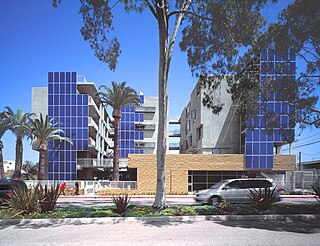
RMIT University, officially the Royal Melbourne Institute of Technology, is a public research university in Melbourne, Australia.

Carlton is an inner-city suburb in Melbourne, Victoria, Australia, three kilometres north of the Melbourne central business district within the City of Melbourne local government area. Carlton recorded a population of 16,055 at the 2021 census.

Peter Russell Corrigan was an Australian architect and was involved in the completion of works in stage and set design.

RMIT University Library consists of six academic branch libraries in Australia and Vietnam. Its four Australian branches are located on the RMIT University campuses in Melbourne City, Bundoora and Brunswick; and its two Vietnamese branches are located at the RMIT University Vietnam campuses in Ho Chi Minh City and Hanoi.

Council House 2 (also known as CH2), is an office building located at 240 Little Collins Street in the Melbourne central business district, Australia. It is used by the City of Melbourne council, and in April 2005, became the first purpose-built office building in Australia to achieve a maximum Six Green Star rating, certified by the Green Building Council of Australia. CH2 officially opened in August 2006.
The Melbourne City campus of the Royal Melbourne Institute of Technology is located in the city centre of Melbourne in Victoria, Australia. It is sometimes referred to as "RMIT City" and the "RMIT Quarter" of the city in the media.

Storey Hall, located at 342–344 Swanston Street in Melbourne, Australia, is part of the RMIT City campus of the Royal Melbourne Institute of Technology. It consists of a grand meeting hall constructed in 1887, extended and renovated in 1996, providing a large upper hall, the lower hall as home to RMIT Gallery First Site, and a range of lecture theatres and seminar rooms.

Colorado Court Housing is a 44-unit housing project designed by the architectural firm Pugh + Scarpa. Colorado Court is the first United States Green Building Council (USGBC) "LEED" certified multi-family housing project, achieving "Gold" certification. Located at the corner of a main offramp of the Santa Monica freeway, Colorado Court's highly visible position makes it gateway to the city of Santa Monica, California. The 44-unit, five-story building is the first affordable-housing project the United States to be LEED certified and is nearly 100% energy neutral (Colorado Court Movie Clip). This project is an excellent model of sustainable development in an urban environment, provides a model for private/public partnerships benefit the community, and promotes diversity in an urban environment through strategically placed affordable housing.

The G. Wayne Clough Undergraduate Learning Commons, commonly referred to by its acronym CULC, is an academic building on the main campus of the Georgia Institute of Technology. The five-story, 220,000 sq ft (20,000 m2) building houses classrooms, science laboratories, academic services, commons areas, and is managed by and connected to the Georgia Tech Library. Named in honor of President Emeritus G. Wayne Clough, the Clough Commons cost $85 million and opened in the fall of 2011.

Frederick Romberg,, , was a Swiss-trained architect who migrated to Australia in 1938, and became a leading figure in the development of Modernism in his adopted city.

RMIT Building 8 is an educational building, part of RMIT University's City campus in Melbourne, Victoria. It is located at 383 Swanston Street, on the northern edge of Melbourne's central business district.
Lyons is an Australian architecture firm based in Melbourne. Established in 1996 by brothers Corbett Lyon and Carey Lyon, they were soon joined by third brother Cameron, Neil Appleton and Adrian Stanic, and are all now directors. Lyons is known for large commercial and institutional buildings such as the RMIT Swanston Academic Building, Melbourne, the Australian Institute of Architects (Victoria), 41 Exhibition St, Melbourne, the John Curtin School of Medical Research in Canberra, the Central Institute of TAFE in Perth, the Queensland Children's Hospital in Brisbane, the School of Medicine and Menzies Research Institute in Hobart and the School of Medicine and Research in Sydney.
Corbett Marshall Lyon is an Australian architect, art patron and academic who lives and works in Melbourne. He is a founding director of Melbourne architectural firm Lyons. With partners Carey Lyon, Cameron Lyon, Neil Appleton, Adrian Stanic and James Wilson he has designed many award-winning institutional and public buildings in Australia.

The RMIT Design Hub is a research, archive, exhibition, and studio space of the Royal Melbourne Institute of Technology in Melbourne, Australia located on the historic Carlton & United Breweries site.

The MacFarland Library at Ormond College, the University of Melbourne, completed in 1965, was Frederick Romberg’s second building for Ormond College. The initial scheme for the building in 1962 was a largely classical building that drew on elements from many of Romberg’s buildings from the previous decade. The subsequent revised scheme better complemented the rest of Reed and Barnes’ Gothic Revival Ormond college. The central plan of the library is a tribute to long tradition of library building including the Melbourne Public Library’s domed reading room, which involved Joseph Reed, Selwyn Bates, Norman Peebles and Charles Smart.

The David and Lucile Packard Foundation Headquarters is the corporate headquarters of the David and Lucile Packard Foundation, located in Los Altos, California. The Packard Foundation was created in 1964 by David Packard and his wife Lucile Salter Packard, one of the top 100 grant-making foundations in the United States, with the goals of improving the lives of children, enabling the creative pursuit of science, advancing reproductive health, and conserving and restoring the Earth’s natural systems. The David and Lucile Packard Foundation Headquarters is designed by EHDD to be the largest net zero energy building in California, and it has successfully reduced the energy use by 65% over conventional buildings.
Emma Young is an Australian architect, born in Sydney in 1971.

The UTS Vicki Sara Building, also known as the Science Faculty Building, is the building housing the Faculty of Science and the Graduate School of Health in the University of Technology Sydney in New South Wales, Australia. It is the third building to be opened under the plan for $154 million worth of structures designed by Durbach Block Jaggers (DBJ) in association with BVN Architecture constructed by Richard Crookes Constructions.
The Melbourne Prize (Architecture) is awarded by a jury appointed by the Victorian chapter of the Australian Institute of Architects to projects that have made a significant contribution to the civic life of Melbourne. It was first awarded in 1997 to Six Degrees Architects for the small bar Meyers Place. All nominated projects located within the Urban Growth Boundary of the Melbourne metropolitan area are eligible for consideration of the prize. The winner is drawn from direct-entry categories in the Victorian Architecture Awards.

UTS Central, also known as Building 2, is the building housing the Faculty of Law and UTS Library at the University of Technology Sydney. It is the final building to be opened under the A$1 billion City Campus Master Plan. The building is designed by Francis-Jones Morehen Thorp (FJMT), with elements of an original podium design by Lacoste+Stevenson in association with DJRD. Construction was overseen by head contractor Richard Crookes Constructions. The building is located next to the UTS Tower in Ultimo. It opened in August 2019.





















